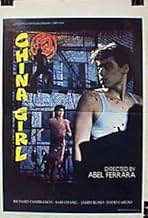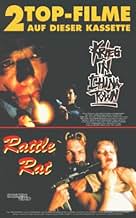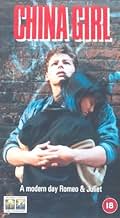IMDb RATING
6.3/10
2.5K
YOUR RATING
An Italian boy and Chinese girl fall in love in New York, igniting a conflict between their ethnic gangs.An Italian boy and Chinese girl fall in love in New York, igniting a conflict between their ethnic gangs.An Italian boy and Chinese girl fall in love in New York, igniting a conflict between their ethnic gangs.
- Awards
- 1 nomination
- Director
- Writer
- All cast & crew
- Production, box office & more at IMDbPro
Storyline
Did you know
- TriviaOut of all of the films he has directed, Abel Ferrara has stated that "China Girl" is his favorite.
- Crazy creditsAfter the credits there is a line: Dedicated to the people of Chinatown and Little Italy.
- Alternate versionsThe UK video version was cut by 7 seconds to remove the use of a butterfly knife. The Columbia DVD features the same cut print.
Featured review
It's a story told so many times it belongs to our cultural DNA, the heartbreaking tale of star-crossed lovers, featuring more or less the same archetypes: tribal rivalries, protective siblings, forbidden rendezvous, declarations of undying love and ultimately a tragic ending... it's a story told in bloody letters and that found its deepest resonance in the deaths of Juliet and her Romeo. But it wasn't the first romance of its kind as men always knew the meaning and value of love, and of hatred (as both go along anyway).
The story never gets old because it's about enduring values for every culture and civilization: love and family, both seal the idea that our hearts can't evolve in autopilot mode, we either belong to our inner circle or the person we love, never to ourselves and this might be the source of some antagonism. Out of love, one is willing to free himself from the clan to belong to the outsider, contradicting the traditional vision of love as a tool to perpetuate the tradition, to ensure transmission, a mean to a non-end. One who is alone is always weaker.
And it's not surprising that Abel Ferrara, of all the directors, used the "Romeo and Juliet" or "West Side Story" canvas to make his "China Girl", he does care for the romance and handles it with sweet sensitivity but to better insist on the clan systems that make it impossible and doomed. The love story is between a young Italian-American played by Richard Panebianco (he was 16 during the film) and Tye, a beautiful Chinese girl played by Sari Chang. The romance works but even more as the subplot of something a little more in line with Ferrara's universe, a gang war between kids from Little Italy and Chinatown, a fight for territory, enhancing the necessity of sticking together, making the lone wolf the weakest link, and codifying love under the rule of "blood".
"China Girl" isn't a remake of the Jets vs. the Sharks antagonism despite the similarities (even the hero's name is Tony), but a violent commentary on urban youth and its natural inclination for violence driven by pride, the more you love your own, the less you care for the other and sometimes, the stronger you despise him. The film opens with a misleading scene showing a Cantonese restaurant being built under the sorry eyes of an Italian neighborhood. In the pizzeria right from the other side, James Russo (he's Tony's brother and has connections with the local mob boss played by Robert Miano), we see the war coming between two cultures. But the film toys with archetypes to better subvert them, revealing depths that are a credit to Ferrara's intelligence.
Indeed, the real antagonism isn't intercultural but intergenerational, while the young ones try to make ends meet by spreading their influence or forcing local shops to pay tributes in exchange of protection, their elders try to maintain peace. We see in a crucial face-off between the local Mafioso and the Chinese "Godfather" (played by James Hong) that the young punks only bring disturbance, interfering with their own interests. In a way, the young generation is lead to its own, paradoxically acting against their elders' values while duplicating them. It's ironic that Tye's brother (Russell Wong) wants to protect her from seeing an Italian while his uncle is treating with one.
These quiet drama moments show that this is not your usual urban warfare though the racist undertones are much real, the catalyst is a cultural self-preservative instinct that predominates in the hearts of young people and make them act violently and desperately. That's the real tragedy: that violence might be targeting the other but is somewhat directed toward yourself.
Ferrara has often been labeled as a poor man's Scorsese and it's tempting to spot the similarities between his urban landscape and exploration of tribal violence with films like "Mean Streets" (the film even features the obligatory Virgin Mary procession in that iconic street) but Ferrara injects his own iconoclast perception. His film doesn't really condemn violence (without endorsing it) as much as it highlights its deep roots in social units. In his "Funeral" film, brothers were all united in the imminence of their downfall, in "Bad Lieutenant" a cop was contaminated by the moral corruption he faced every day. And even "Body Snatchers" showed that the trouble can come from within and that perhaps there's no possible deliverance as long as we "belong" to a group.
It's a vicious circle where violence isn't exactly an evil but an inevitable path to cross, maybe a rite of passage making you either a bad person or a victim, no other way around. The real paradox is that for all their diverging traits, kids dress the same, are equally violent or brotherly, they dance to the same pop music, go to the same night clubs. There's something also very conformist in youth and perhaps that's why the film indulges to so many 80s clichés. With the atmosphere of an 80s clip, the film has the films conveys the vibes of that era making it a decade-defining film but there's more than style that dictates Ferrara's touch. The director doesn't make his film a hymn against racism because both Tony and Tye don't see the differences, they have the same age, the same aspirations and they met at the same night-club and enjoyed the same music.
The tragedy isn't that their love causes trouble because they belong to different communities but because there aren't many differences to begin with. That's the illusion of youth, it pretends to rebel against an order while forming an even more violent one, it's all about peer pressure and love impulses, in the name of differences and tacit laws that are futile and ultimately dangerous. Ferrara does turns a classic romantic material into a real hymn for anarchy... one that would make Marco Polo roll over his grave.
The story never gets old because it's about enduring values for every culture and civilization: love and family, both seal the idea that our hearts can't evolve in autopilot mode, we either belong to our inner circle or the person we love, never to ourselves and this might be the source of some antagonism. Out of love, one is willing to free himself from the clan to belong to the outsider, contradicting the traditional vision of love as a tool to perpetuate the tradition, to ensure transmission, a mean to a non-end. One who is alone is always weaker.
And it's not surprising that Abel Ferrara, of all the directors, used the "Romeo and Juliet" or "West Side Story" canvas to make his "China Girl", he does care for the romance and handles it with sweet sensitivity but to better insist on the clan systems that make it impossible and doomed. The love story is between a young Italian-American played by Richard Panebianco (he was 16 during the film) and Tye, a beautiful Chinese girl played by Sari Chang. The romance works but even more as the subplot of something a little more in line with Ferrara's universe, a gang war between kids from Little Italy and Chinatown, a fight for territory, enhancing the necessity of sticking together, making the lone wolf the weakest link, and codifying love under the rule of "blood".
"China Girl" isn't a remake of the Jets vs. the Sharks antagonism despite the similarities (even the hero's name is Tony), but a violent commentary on urban youth and its natural inclination for violence driven by pride, the more you love your own, the less you care for the other and sometimes, the stronger you despise him. The film opens with a misleading scene showing a Cantonese restaurant being built under the sorry eyes of an Italian neighborhood. In the pizzeria right from the other side, James Russo (he's Tony's brother and has connections with the local mob boss played by Robert Miano), we see the war coming between two cultures. But the film toys with archetypes to better subvert them, revealing depths that are a credit to Ferrara's intelligence.
Indeed, the real antagonism isn't intercultural but intergenerational, while the young ones try to make ends meet by spreading their influence or forcing local shops to pay tributes in exchange of protection, their elders try to maintain peace. We see in a crucial face-off between the local Mafioso and the Chinese "Godfather" (played by James Hong) that the young punks only bring disturbance, interfering with their own interests. In a way, the young generation is lead to its own, paradoxically acting against their elders' values while duplicating them. It's ironic that Tye's brother (Russell Wong) wants to protect her from seeing an Italian while his uncle is treating with one.
These quiet drama moments show that this is not your usual urban warfare though the racist undertones are much real, the catalyst is a cultural self-preservative instinct that predominates in the hearts of young people and make them act violently and desperately. That's the real tragedy: that violence might be targeting the other but is somewhat directed toward yourself.
Ferrara has often been labeled as a poor man's Scorsese and it's tempting to spot the similarities between his urban landscape and exploration of tribal violence with films like "Mean Streets" (the film even features the obligatory Virgin Mary procession in that iconic street) but Ferrara injects his own iconoclast perception. His film doesn't really condemn violence (without endorsing it) as much as it highlights its deep roots in social units. In his "Funeral" film, brothers were all united in the imminence of their downfall, in "Bad Lieutenant" a cop was contaminated by the moral corruption he faced every day. And even "Body Snatchers" showed that the trouble can come from within and that perhaps there's no possible deliverance as long as we "belong" to a group.
It's a vicious circle where violence isn't exactly an evil but an inevitable path to cross, maybe a rite of passage making you either a bad person or a victim, no other way around. The real paradox is that for all their diverging traits, kids dress the same, are equally violent or brotherly, they dance to the same pop music, go to the same night clubs. There's something also very conformist in youth and perhaps that's why the film indulges to so many 80s clichés. With the atmosphere of an 80s clip, the film has the films conveys the vibes of that era making it a decade-defining film but there's more than style that dictates Ferrara's touch. The director doesn't make his film a hymn against racism because both Tony and Tye don't see the differences, they have the same age, the same aspirations and they met at the same night-club and enjoyed the same music.
The tragedy isn't that their love causes trouble because they belong to different communities but because there aren't many differences to begin with. That's the illusion of youth, it pretends to rebel against an order while forming an even more violent one, it's all about peer pressure and love impulses, in the name of differences and tacit laws that are futile and ultimately dangerous. Ferrara does turns a classic romantic material into a real hymn for anarchy... one that would make Marco Polo roll over his grave.
- ElMaruecan82
- Mar 31, 2020
- Permalink
- How long is China Girl?Powered by Alexa
Details
Box office
- Budget
- $3,500,000 (estimated)
- Gross US & Canada
- $1,262,091
- Opening weekend US & Canada
- $531,362
- Sep 27, 1987
- Gross worldwide
- $1,262,091
- Runtime1 hour 30 minutes
- Color
- Sound mix
- Aspect ratio
- 1.85 : 1
Contribute to this page
Suggest an edit or add missing content





























